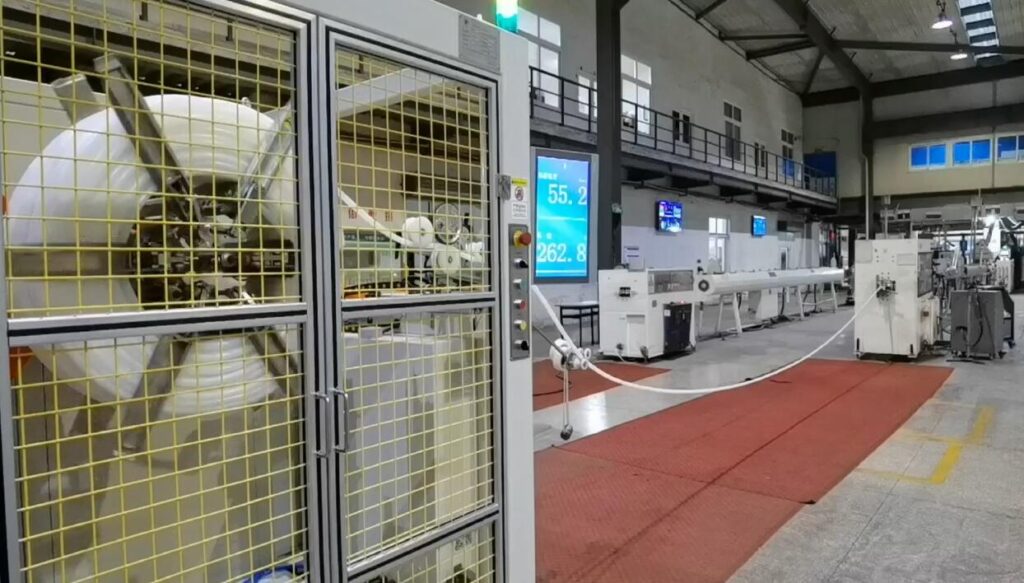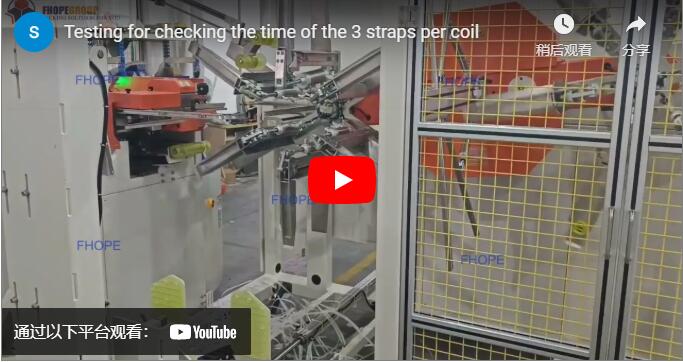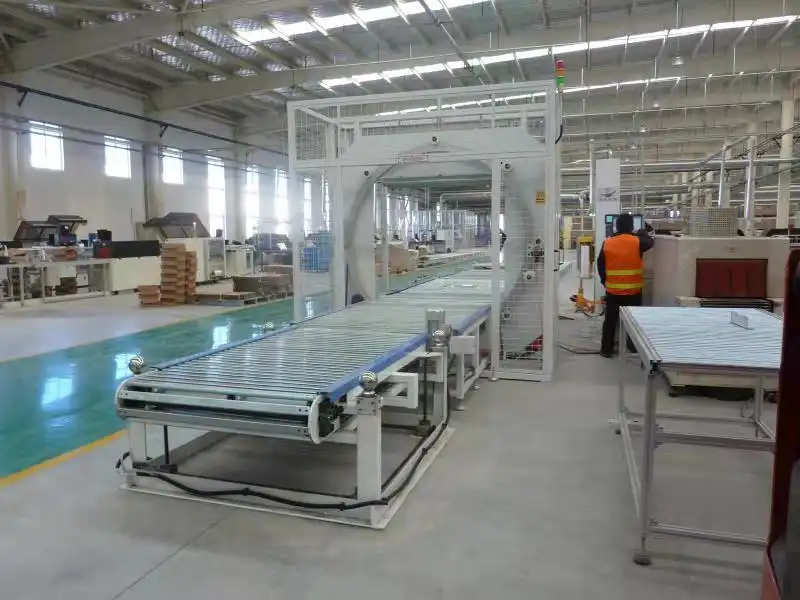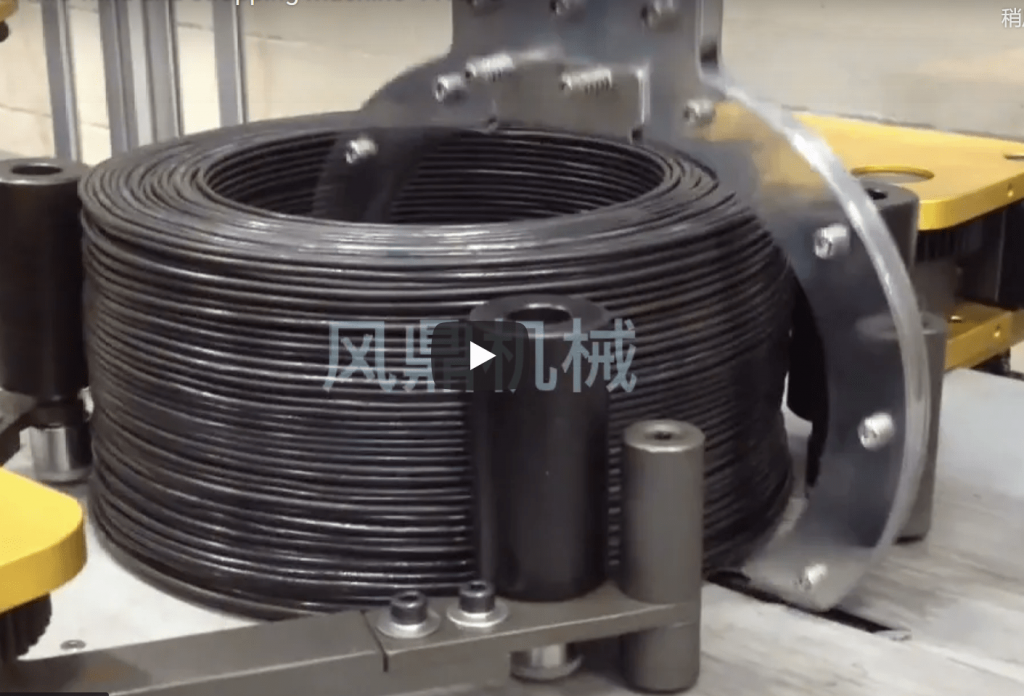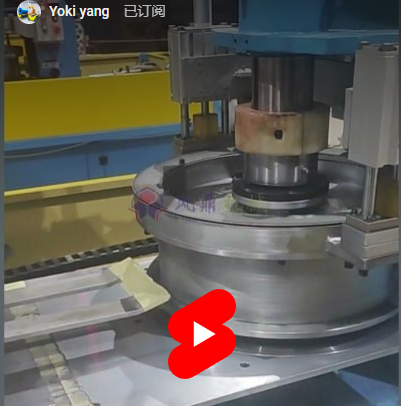This is a video for Automatic steel coil strapping machine for slit coil.
How Automatic Steel Coil Strapping Machines for Slit Coil Are Transforming the Steel Industry Globally
The steel industry is the backbone of modern infrastructure, powering everything from skyscrapers to automotive manufacturing. Yet, in this fast-paced, high-demand world, efficiency is the key to staying competitive. For decades, steel mills and service centers relied on manual or semi-automated processes to package slit steel coils. These methods were labor-intensive, error-prone, and inefficient, often resulting in wasted time and resources. Enter the automatic steel coil strapping machine—a game-changing innovation that is transforming how the industry operates globally.
Imagine a machine that not only secures heavy slit coils with precision but also reduces labor dependency, minimizes errors, and improves overall productivity. The automatic steel coil strapping machine achieves all this and more. By automating the strapping process, these machines deliver consistent results, enhance safety, and ensure coils are securely packed for transportation or storage. The result? Smoother operations, lower costs, and a significant boost in efficiency.
Gone are the days when packaging steel coils required hours of manual labor. With the advent of cutting-edge automated strapping technology, the steel industry is experiencing a shift toward precision and speed. But what exactly makes these machines indispensable? And how do they cater to the unique needs of steel manufacturers? This article takes a deep dive into the transformative impact of automatic steel coil strapping machines for slit coils, exploring their features, benefits, and the value they bring to the global steel industry.
These machines are more than just tools; they are strategic investments that yield measurable results. By enhancing operational efficiency, ensuring safety compliance, and reducing waste, they empower companies to remain competitive in an ever-evolving market. Let’s explore why the automatic steel coil strapping machine is the future of steel manufacturing.
1. How do automatic strapping machines enhance efficiency in steel packaging?
1.1 What makes automatic strapping machines faster than manual alternatives?
The speed of the automatic steel coil strapping machine is unmatched, delivering results that manual methods simply cannot replicate. Traditional strapping processes often require multiple workers to maneuver heavy coils, position straps, and secure them in place. This can take up to 10-15 minutes per coil, depending on its size and weight. In contrast, automatic machines can complete the same task in under 2 minutes, offering a time-saving of over 85% per coil.
This rapid strapping process is achieved through advanced automation technologies, including sensors, programmable logic controllers (PLCs), and robotic arm integration. These features ensure precise alignment, consistent tension, and flawless execution without the need for manual intervention. For steel mills processing hundreds of coils daily, this means saving hours of labor while maintaining high-quality packaging standards.
1.2 How do these machines reduce operational costs while improving precision?
Automatic steel coil strapping machines are designed to streamline operations, reducing both direct and indirect costs. Here’s a breakdown of how they achieve this:
| Cost Factor | Manual Strapping | Automatic Strapping |
|---|---|---|
| Labor Costs | $25,000 annually per worker | $5,000 in maintenance and power |
| Error-Related Losses | $10,000/year (damaged coils) | <$1,000/year |
| Time Efficiency | 10-15 minutes per coil | <2 minutes per coil |
By automating the strapping process, companies can reduce their reliance on manual labor, which is not only costly but also inconsistent in quality. In addition, these machines minimize the risk of errors such as loose straps or uneven tension, which can compromise the safety of the packaged coils.
For example, a major steel manufacturer integrated automatic strapping machines into their production line and reduced their annual labor costs by 40%, while improving packaging precision by 95%.
1.3 Key features that make these machines indispensable
The automatic steel coil strapping machine is packed with features that cater to the specific needs of the steel industry:
- High-Speed Operation: Strapping a coil in under 2 minutes ensures high throughput.
- Customizable Strapping Patterns: Adjust strapping positions, tension, and material for different coil types.
- Durable Build: Designed to handle heavy-duty applications, withstanding harsh industrial environments.
- Safety Sensors: Automatic stop mechanisms prevent accidents during operation.
- Energy Efficiency: Low power consumption reduces operational costs.
These features make the machine not just a convenience but a necessity for steel manufacturers looking to optimize their operations.
1.4 Dive deeper: The ROI of investing in automatic strapping machines
Investing in an automatic steel coil strapping machine may seem like a significant expense upfront, but the returns far outweigh the costs. Here’s a detailed comparison:
| Metric | Manual Strapping | Automatic Strapping |
|---|---|---|
| Initial Investment | $5,000 (tools, training) | $50,000-$70,000 (one-time) |
| Annual Maintenance Costs | $1,500 | $2,000 |
| Time Saved (per year) | N/A | 1,000+ hours |
| Total ROI Over 5 Years | Moderate | High |
For high-production facilities, the ROI can be achieved within the first 12-18 months, thanks to reduced labor costs, faster turnaround times, and improved packaging quality.
1.5 Two Fact Statement
- True: Automatic strapping machines can reduce strapping time by over 85% compared to manual methods.
- False: These machines are only suitable for lightweight coils and cannot handle heavy-duty applications.
2. What safety and compliance advantages do these machines offer?
2.1 How do automatic strapping machines improve workplace safety?
In industrial environments, especially steel mills and service centers, safety is paramount. Handling heavy slit steel coils manually or using semi-automated equipment often exposes workers to risks such as injuries from coil movement, improper strap tensioning, or repetitive strain. Automatic steel coil strapping machines mitigate these risks by automating the most hazardous parts of the process.
These machines feature built-in safety mechanisms, such as sensors to stop operation when obstructions are detected, ensuring that workers are not in harm’s way during strapping. Additionally, the automation eliminates the need for workers to manually adjust straps or operate heavy tools near the coils, significantly reducing the risk of accidents. By creating a safer work environment, these machines not only protect workers but also help employers comply with strict safety regulations.
2.2 The certifications that ensure global compliance
Automatic steel coil strapping machines are designed to meet the highest safety and compliance standards, making them suitable for use across global markets. These machines are typically certified under internationally recognized standards, ensuring they meet legal and operational requirements.
| Certification/Standard | Purpose | Benefits |
|---|---|---|
| CE Marking | Compliance with EU safety standards | Ensures safe operation in Europe |
| ISO 45001 | Occupational health and safety | Reduces workplace risks |
| UL Certification | Electrical safety compliance | Ensures safe operation in the US |
| RoHS Compliance | Restricts hazardous substances | Promotes environmental safety |
For example, a steel manufacturer exporting slit coils to Europe and North America benefited greatly from integrating CE- and UL-certified strapping machines. This ensured smooth operations while meeting the safety and environmental guidelines of both regions.
2.3 Dive deeper: Comparing safety metrics before and after automation
The impact of automatic strapping machines on workplace safety can be measured through key metrics. Here’s a comparison of safety statistics before and after implementing automation:
| Metric | Before Automation | After Automation |
|---|---|---|
| Annual Work Injuries (avg.) | 15 | 2 |
| Injury-Related Downtime (hours) | 120 | <10 |
| OSHA Compliance Fines | $5,000/year | $0 |
By reducing injuries and associated downtime, these machines not only protect workers but also save companies significant costs related to medical expenses, fines, and lost productivity.
2.4 Conclusion
The integration of automatic steel coil strapping machines is not just about operational efficiency—it’s about creating a safer work environment. By automating high-risk tasks, these machines drastically reduce the likelihood of workplace injuries, ensuring compliance with global safety standards. For companies looking to prioritize safety while boosting productivity, these machines are a must-have investment.
2.5 Two Fact Statement
- True: Automatic steel coil strapping machines reduce workplace injuries by automating hazardous tasks.
- False: These machines are not compliant with globally recognized safety standards.
3. How customizable are automatic steel coil strapping machines for industry needs?
3.1 Modular designs for diverse operations
One of the most impressive features of automatic steel coil strapping machines is their modular design, which allows for seamless integration into various production lines. Whether you’re working with lightweight coils for consumer products or heavy-duty industrial coils, these machines can be customized to meet specific requirements.
For instance, modular strapping heads and adjustable coil supports make it easy to accommodate different coil diameters and weights. Additionally, manufacturers can choose from a variety of strapping materials (e.g., steel or PET straps) and tensioning levels to match the unique demands of their operations. This flexibility ensures that the machines can adapt to diverse use cases, maximizing their value across industries.
3.2 The role of IoT and real-time monitoring
With advancements in technology, many strapping machines now come equipped with IoT (Internet of Things) capabilities, allowing for real-time monitoring and data collection. This feature is especially beneficial for large-scale operations, where efficiency and consistency are critical.
| IoT Feature | Functionality | Benefit |
|---|---|---|
| Remote Monitoring | Track machine performance online | Reduces downtime |
| Predictive Maintenance Alerts | Identifies potential issues early | Avoids unexpected breakdowns |
| Data Analytics | Analyzes strapping patterns | Optimizes operations |
| Integration with ERP Systems | Syncs with production data | Enhances workflow management |
For example, a steel mill integrated IoT-enabled strapping machines with its ERP system, reducing downtime by 30% through predictive maintenance and real-time performance tracking.
3.3 Benefits of custom configurations for specific processes
Customization is key to achieving maximum efficiency. Automatic strapping machines can be tailored to meet specific operational needs, such as strapping positions, coil orientations, or even unique packaging requirements.
Key Benefits of Custom Configurations:
- Improved Productivity: Machines optimized for specific workflows can process coils faster.
- Higher Accuracy: Custom tension levels and alignment ensure secure packaging.
- Reduced Waste: Tailored strapping patterns minimize material usage.
For instance, a service center specializing in slit coils for the automotive industry configured its machines to apply precise tension levels suited for high-value products. This customization led to a 20% reduction in material waste and ensured that the coils met the exacting standards required by their automotive clients.
4. How are automatic strapping machines driving global competitiveness?
4.1 The role of automation in reducing production timelines
In the highly competitive global steel industry, reducing production timelines is critical for meeting client demands and maintaining a competitive edge. Automatic steel coil strapping machines play a pivotal role in achieving this by streamlining the packaging process.
With the ability to strap a coil in under 2 minutes compared to the 10-15 minutes required for manual methods, these machines significantly reduce bottlenecks in the production line. For steel mills producing hundreds of coils daily, this time savings translates into faster order fulfillment and improved customer satisfaction.
Additionally, the machines’ precision eliminates the need for rework, ensuring that coils are securely strapped and ready for transport or storage on the first attempt. For global players in the steel industry, this efficiency is a game-changer, enabling them to meet tight deadlines and maintain a reliable supply chain.
4.2 How these machines improve supply chain reliability
Supply chain reliability is a cornerstone of global competitiveness, and automatic strapping machines contribute to this in several ways. By automating the strapping process, these machines ensure that coils are consistently packaged to withstand the rigors of transportation, reducing the risk of damage and delays.
| Key Benefits | Impact on Supply Chain |
|---|---|
| Consistent Packaging Quality | Reduces damage during transport |
| Faster Turnaround Times | Improves delivery schedules |
| Reduced Human Error | Ensures accurate strapping |
For example, a steel exporter using automatic strapping machines reported a 30% decrease in shipping delays and a 40% reduction in damaged goods claims, enhancing their reputation as a reliable supplier in the global market.
![Reliable Packaging for Global Supply Chains][]
4.3 The impact of reduced operational costs on global competitiveness
Reducing operational costs is essential for competing in a global market where margins are tight, and price-sensitive customers demand value. Automatic steel coil strapping machines help businesses achieve this by minimizing labor costs, reducing material waste, and improving overall efficiency.
Here’s a cost comparison:
| Cost Factor | Manual Strapping | Automatic Strapping |
|---|---|---|
| Labor Costs | $25,000/year per worker | $5,000/year (maintenance & power) |
| Material Waste | 5-10% of straps wasted | <1% waste |
| Shipping Damage Costs | $10,000/year | <$1,000/year |
For a mid-sized steel mill, the transition to automatic strapping machines resulted in annual savings of $50,000, allowing the company to invest in other areas of growth, such as product development and international expansion.
4.4 Dive deeper: The environmental benefits of automation
In addition to operational and financial benefits, automatic steel coil strapping machines contribute to sustainability efforts, which are becoming increasingly important in the global market. By reducing material waste and energy consumption, these machines help steel manufacturers align with environmental regulations and corporate social responsibility goals.
| Environmental Impact | Manual Strapping | Automatic Strapping |
|---|---|---|
| Strap Waste | 5-10% | <1% |
| Energy Consumption | High (inefficient tools) | Low (optimized power usage) |
| Carbon Footprint | Higher (due to errors and delays) | Lower (streamlined processes) |
For instance, a steel manufacturer in Europe adopted automatic strapping machines and achieved a 20% reduction in energy usage and a 50% decrease in strap waste, helping them meet stringent EU environmental standards.
4.5 Two Fact Statement
- True: Automatic strapping machines reduce material waste, contributing to sustainability efforts in the steel industry.
- False: These machines increase energy consumption compared to manual strapping methods.
Conclusion
The automatic steel coil strapping machine is revolutionizing the global steel industry by enhancing productivity, improving safety, and driving sustainability. Through advanced automation, these machines reduce production timelines, operational costs, and workplace risks, empowering steel manufacturers to remain competitive in an ever-evolving market.
Furthermore, their adaptability and scalability make them suitable for diverse operations, from small service centers to large-scale manufacturing facilities. By integrating IoT technologies and ensuring compliance with global standards, these machines not only streamline production but also promote supply chain reliability and environmental responsibility.
For companies aiming to stay ahead in the global steel industry, investing in automatic steel coil strapping machines is not just an option—it’s a necessity. They represent the future of industrial packaging, where efficiency, safety, and sustainability converge to deliver unparalleled value.
